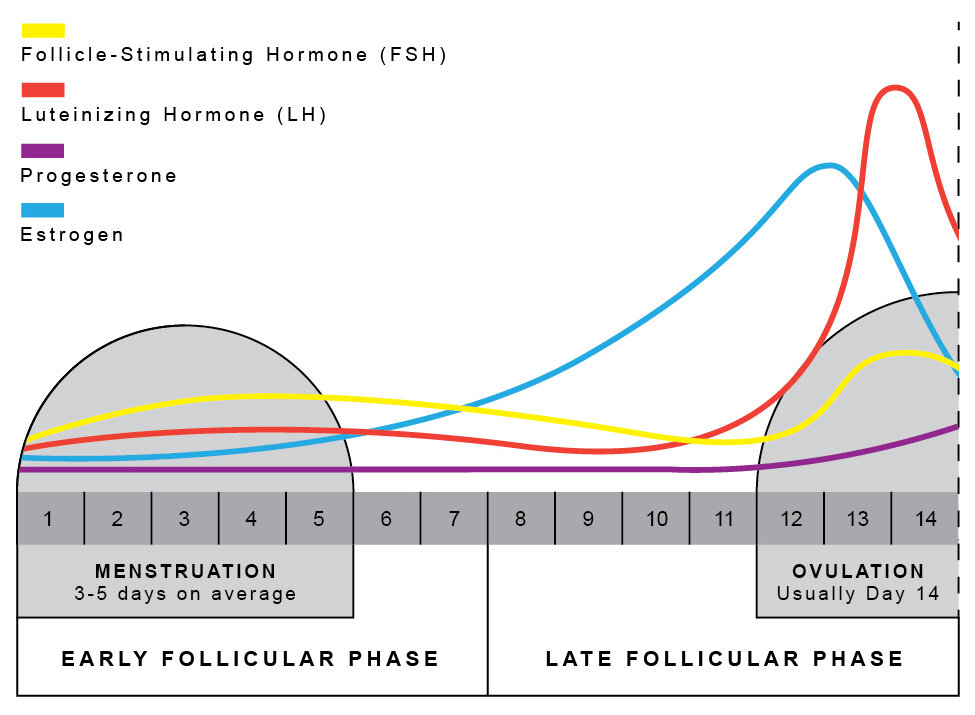As a woman your approach to nutrition, dieting and fat loss should differ to what is a relatively straightforward process for a man.
The concept of energy balance still rings true, of that there is no question (or argument), but due to the hormonal changes that take place during the menstrual cycle it is worth understanding the impact that this has on a woman’s physiology.
But before we even delve into some of the basic hormonal changes that occur, it’s important that we understand what the menstrual cycle actually is.
The average length of the menstrual cycle is 28 days, but anywhere from 23-32 days is considered to be normal.
The primary purpose of the menstrual cycle is to prepare the female body for pregnancy, and most of the hormonal changes that occur and their effects are aimed at reaching this goal.
You would think that all the changes that occur would be the same for every woman, but that would be too simple. Whilst certain hormonal changes may occur for all women there will be differences from one to the other, and any given woman can vary from one month to the next. Some may see their strength and endurance in the gym vary massively, whilst others may see no change at all. During the final week of the cycle some women may have severe mood swings, fatigue and even depression, whilst others may have no issues at all. Add in a large number of other factors such as diet, exercise and stress and the cycle can be further disrupted from one woman to the next.
In as simplistic way as possible, and with my limited understanding, I shall attempt to break down each phase of the menstrual cycle and try to explain what occurs in a woman’s physiology, and the effect this has on fuel utilisation, fat storage, hunger, appetite and water retention, as well as the impact that the reproductive hormones can have on how you should approach your fat loss goals.
Follicular Phase
The first phase of the menstrual cycle is the follicular phase. This typically lasts around 14 days but can vary from cycle to cycle, and woman to woman.
The Follicular Phase starts at the beginning of the period and lasts until ovulation.
The pituitary gland produces a hormone called follicle-stimulating hormone (FSH). FSH basically tells the ovaries to prepare an egg for ovulation. There are multiple follicles developed, and about halfway through the phase, just as the period is ending, one of these follicles becomes the dominant one and is prepared by the ovaries to be released.
Hormonally estrogen and progesterone are both relatively low, but as this dominant follicle grows estrogen begins to increase leading up to a large surge in the final few days. Luteinizing Hormone (LH) is another important hormone that controls estrogen production and ovulation. Ovulation is marked when LH causes the follicle to burst, which releases an egg into the fallopian tubes. In short, at this time the vagina is more hospitable to sperm. Pregnancy you say?
What do you really need to know about the Follicular Phase
Insulin sensitivity is high during this phase so a woman’s body will use more carbs for fuel during rest. Blood glucose, hunger and appetite should be pretty stable. The increase in estrogen has a positive effect on muscle development from training. So this phase is the perfect time to weight train. Initially water retention will also be low. During the follicular phase a woman will generally show her lightest bodyweight on the scales.
However, in the 3-4 days prior to ovulation, due to the surge in estrogen, appetite will be significantly reduced and water retention may increase. So towards the final days it would be prudent to reduce the intake of sodium and increase the intake of potassium to help with this potential water retention increase.
Luteal Phase
The second phase of the menstrual cycle is the luteal phase. The release of the egg on or around Day 14 marks not just ovulation, but also the ending of the follicular phase.
The Luteal Phase begins after ovulation, which is usually on, or around, day 14 of a regular cycle.
Over the first half of the luteal phase both progesterone and estrogen gradually increase with progesterone levels higher than those of estrogen. After ovulation body temperature will increase slightly, which cannot only be used when pregnancy is the goal, it also indicates the beginning of the luteal phase.
Later on in this phase as the levels of progesterone and estrogen start to drop is when Pre-Menstrual Syndrome (PMS) will typically occur in 30-40% of women. This can be shown through a number of symptoms such as cramps, mood swings, low energy, depression and breast tenderness.
What do you really need to know about the Luteal Phase
Muscle growth will suffer, and endurance will be negatively impacted due to the increase in body temperature. There is also the potential for sleep to become interrupted later on in the cycle.
Hunger and cravings will tend to go up, with cravings for high-fat and high-sugar foods usually on the agenda. Fat storage will increase, with more fat being used for fuel at rest and during exercise. Blood sugar levels will become unstable which could cause some women to experience hypoglycemia (low blood sugar), which in turn will have a negative affect on hunger, energy and mood swings. Early on in the luteal phase there will be a loss of water and little water retention, but as the cycle progresses and progesterone drops water retention will typically increase to its worst level, especially for women on a high sodium diet.
Basically allow yourself to eat some fruit and chocolate during this phase but towards the final days, as towards the end of the follicular phase, it would be prudent to reduce the intake of sodium and increase the intake of potassium to help with the water retention increase.
Summary
During a normal occurring cycle it would be advisable to set up a diet for each phase. To ensure adequate nutrient intake and to help protect the cycle, red meat or chicken, dairy foods and dietary fat should ideally be consumed. Towards the end of the follicular phase, at the point when appetite decreases and water retention potentially increases, reducing the intake of sodium whilst increasing potassium could be beneficial.
During the luteal phase ensuring that there is some intake of fruit can help to stabilise the bloody glucose, and by allowing yourself a small amount of chocolate it may help with cravings. Towards the end of the luteal phase water retention will likely occur and be at its worst, so making sure there is a reduction of sodium and an increase in potassium is ideal.
However you set up your diet one thing to always bear in mind is that calories matter. Whether you are looking to gain weight, maintain your weight or lose weight. They matter.
Once you have figured out your calorie intake you then need to figure out your macronutrient intake. Even though this is really down to personal preference there are a few key recommendations. During the follicular phase of a regular occurring cycle your carbohydrate intake should be higher than that of your fat intake. This is due to carbohydrate being the main fuel used during rest. As you move into the luteal phase it would be prudent to reduce your carbohydrate intake and increase your fat intake, this is due to fat being the main fuel used during rest. Be careful as you increase your fat intake as fat contains more calories per gram than any other macronutrient. In other words, always, always, always keep in mind your overall calorie intake.
I’m currently working on a nutrition calculator for my website to help you with all these calculations. Once it’s completed I will update this post with a link. For now if you need any help, feel free to contact me.




